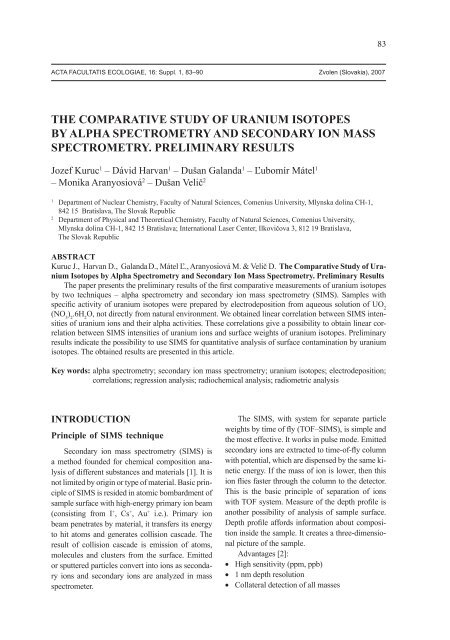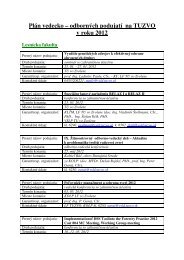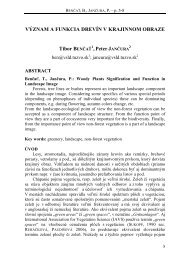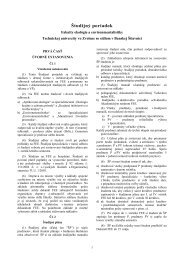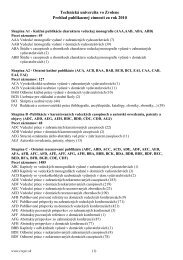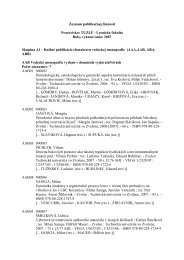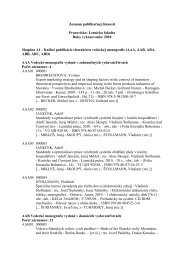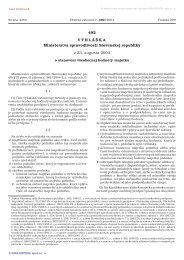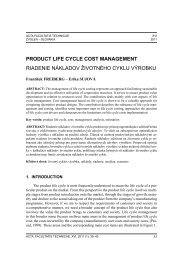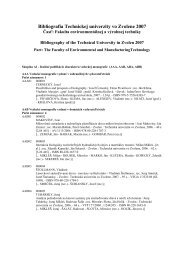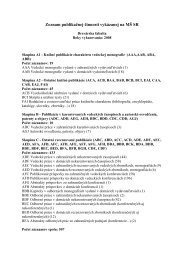Acta Facultatis Ecologiae - Technická univerzita vo Zvolene
Acta Facultatis Ecologiae - Technická univerzita vo Zvolene
Acta Facultatis Ecologiae - Technická univerzita vo Zvolene
- No tags were found...
Create successful ePaper yourself
Turn your PDF publications into a flip-book with our unique Google optimized e-Paper software.
83ACTA FACULTATIS ECOLOGIAE, 16: Suppl. 1, 83–90 Z<strong>vo</strong>len (Slovakia), 2007THE COMPARATIVE STUDY OF URANIUM ISOTOPESBY ALPHA SPECTROMETRY AND SECONDARY ION MASSSPECTROMETRY. PRELIMINARY RESULTSJozef Kuruc 1 – Dávid Harvan 1 – Dušan Galanda 1 – Ľubomír Mátel 1– Monika Aranyosiová 2 – Dušan Velič 21Department of Nuclear Chemistry, Faculty of Natural Sciences, Comenius University, Mlynska dolina CH-1,842 15 Bratislava, The Slovak Republic2Department of Physical and Theoretical Chemistry, Faculty of Natural Sciences, Comenius University,Mlynska dolina CH-1, 842 15 Bratislava; International Laser Center, Ilkovičova 3, 812 19 Bratislava,The Slovak RepublicABSTRACTKuruc J., Harvan D., Galanda D., Mátel Ľ., Aranyosiová M. & Velič D. The Comparative Study of UraniumIsotopes by Alpha Spectrometry and Secondary Ion Mass Spectrometry. Preliminary ResultsThe paper presents the preliminary results of the first comparative measurements of uranium isotopesby two techniques – alpha spectrometry and secondary ion mass spectrometry (SIMS). Samples withspecific activity of uranium isotopes were prepared by electrodeposition from aqueous solution of UO 2(NO 3) 2.6H 2O, not directly from natural environment. We obtained linear correlation between SIMS intensitiesof uranium ions and their alpha activities. These correlations give a possibility to obtain linear correlationbetween SIMS intensities of uranium ions and surface weights of uranium isotopes. Preliminaryresults indicate the possibility to use SIMS for quantitative analysis of surface contamination by uraniumisotopes. The obtained results are presented in this article.Key words: alpha spectrometry; secondary ion mass spectrometry; uranium isotopes; electrodeposition;correlations; regression analysis; radiochemical analysis; radiometric analysisINTRODUCTIONPrinciple of SIMS techniqueSecondary ion mass spectrometry (SIMS) isa method founded for chemical composition analysisof different substances and materials [1]. It isnot limited by origin or type of material. Basic principleof SIMS is resided in atomic bombardment ofsample surface with high-energy primary ion beam(consisting from I + , Cs + , Au + i.e.). Primary ionbeam penetrates by material, it transfers its energyto hit atoms and generates collision cascade. Theresult of collision cascade is emission of atoms,molecules and clusters from the surface. Emittedor sputtered particles convert into ions as secondaryions and secondary ions are analyzed in massspectrometer.The SIMS, with system for separate particleweights by time of fly (TOF–SIMS), is simple andthe most effective. It works in pulse mode. Emittedsecondary ions are extracted to time-of-fly columnwith potential, which are dispensed by the same kineticenergy. If the mass of ion is lower, then thision flies faster through the column to the detector.This is the basic principle of separation of ionswith TOF system. Measure of the depth profile isanother possibility of analysis of sample surface.Depth profile affords information about compositioninside the sample. It creates a three-dimensionalpicture of the sample.Advantages [2]:• High sensitivity (ppm, ppb)• 1 nm depth resolution• Collateral detection of all masses


